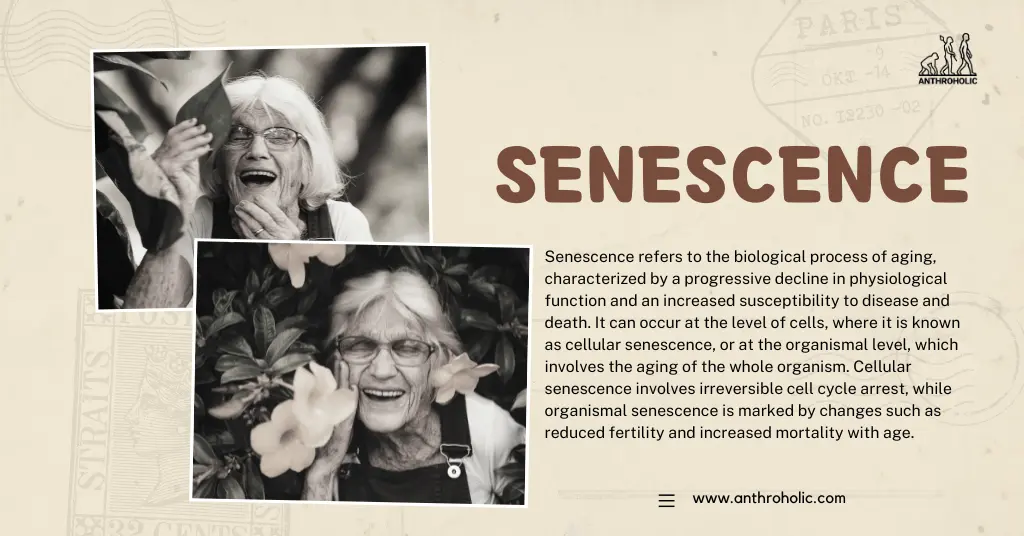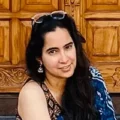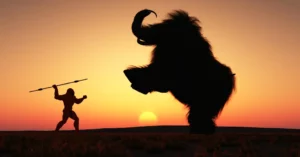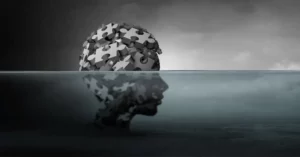Senescence
Senescence refers to the biological process of aging, characterized by a progressive decline in physiological function and an increased susceptibility to disease and death [1]. It can occur at the level of cells, where it is known as cellular senescence, or at the organismal level, which involves the aging of the whole organism. Cellular senescence involves irreversible cell cycle arrest, while organismal senescence is marked by changes such as reduced fertility and increased mortality with age.

History and Background of the Study of Senescence
The scientific study of senescence can be traced back to the 19th century, when German biologist August Weismann proposed that aging was a byproduct of natural selection [2]. He hypothesized that aging, or “programmed death,” served to remove older individuals from a population and make way for younger ones, thereby promoting the survival of the species.
In the 20th century, the idea of programmed aging fell out of favor and was largely replaced by the theory of aging as an accidental byproduct of other biological processes [3]. British biologist Peter Medawar proposed that aging occurred due to an accumulation of small, random genetic errors over time. This became known as the “mutation accumulation” theory of aging.
In 1961, Leonard Hayflick discovered that human cells could only divide a certain number of times before they stopped dividing, a phenomenon now known as the Hayflick limit or cellular senescence [4]. This was a major breakthrough in the field, as it provided a cellular mechanism for aging.
In recent years, there has been increasing interest in understanding the genetic and molecular mechanisms of senescence, with studies focusing on topics such as the role of telomeres in cellular aging and the impact of environmental factors like diet and stress on the aging process.
Valuing or Stigmatizing Aging in Various Societies
In certain societies, particularly those in the West, there can be a strong cultural emphasis on youth and beauty, leading to stigmatization of aging. However, in many traditional societies, age is highly respected, and elder individuals are valued for their wisdom and experience. In cultures such as those in Native American tribes or African societies, elders often serve as advisors and arbitrators, their age and life experience enhancing their status in the community.
Societal Roles and Expectations of Individuals as they Age
Societal roles of aging individuals also vary by culture. In many societies, age is associated with changing roles and expectations. These societal norms can greatly influence how individuals experience aging.
- Status and Respect: In some cultures, age is associated with wisdom and experience, and older individuals may be afforded a higher status or level of respect. For example, in many traditional societies, elders are looked upon as sources of wisdom and guidance, and they play key roles in decision-making processes at both the family and community levels.
- Changing Family Roles: As individuals age, they may experience changes in their family roles. For example, becoming a grandparent often involves new responsibilities and expectations. At the same time, older individuals may become more reliant on family support due to health issues or the loss of a spouse.
- Work and Retirement: Work roles also shift with age. In many societies, older individuals are expected to retire from the workforce. The transition to retirement can be a significant life change, with implications for an individual’s sense of identity, financial status, and daily routines.
- Expectations Around Health and Independence: Societal norms and expectations can influence how older individuals perceive their own health and independence. Some cultures place a strong emphasis on independence and may view the need for assistance or care as a loss of dignity, while others view the provision of care for older family members as a natural and expected responsibility.
Rites of Passage or Ceremonies Associated with Aging
Cultures around the world mark the transition into old age with various rites and ceremonies. For example, in Japan, a celebration known as “Kanreki” marks the completion of the 60-year zodiac cycle, symbolizing rebirth and a return to childhood. In some Native American cultures, elders are honored with special ceremonies recognizing their wisdom and contributions to the community.
Theories of Biological Senescence
There are several prominent theories of biological senescence, including the evolutionary theory, the free radical theory, and the telomere theory.
- The evolutionary theory proposes that aging is not directly programmed but is a byproduct of the decrease in natural selection with age [5].
- The free radical theory, proposed by Denham Harman, suggests that aging results from the accumulation of damage by free radicals, reactive particles that can harm cells and DNA [6].
- The telomere theory proposes that cellular aging results from the gradual shortening of telomeres, protective caps on the ends of chromosomes, during cell division [7].
Influence of Genetics and Environmental Factors on Senescence
The aging process is, in part, controlled by our genes. For example, certain genetic variations are known to be associated with longevity, and familial clustering of long-lived individuals suggests a significant heritable component to lifespan. At a cellular level, various processes such as DNA repair, telomere shortening, and mitochondrial function, all of which are regulated by genes, play critical roles in senescence. Additionally, genetic research on model organisms such as yeast, nematodes, and fruit flies has identified numerous “longevity genes” that regulate lifespan, many of which have human homologs.
Impact of Senescence on the Human Body and Mind
Senescence can lead to a variety of physical and cognitive changes. Physically, aging is often accompanied by reduced muscle strength, decreased bone density, changes in body composition, and increased vulnerability to disease. Cognitive changes can include slower processing speed, memory decline, and increased risk of neurodegenerative disorders like Alzheimer’s disease.
Societal Responses to Senescence
Societal responses to senescence can take various forms, including institutional, cultural, and policy responses. Institutional responses often involve the development of facilities like retirement homes and senior community centers. Cultural practices may include rituals or traditions honoring the elderly, or practices that assign them particular roles within the society. Policy responses can include government programs like Social Security or healthcare initiatives targeting older populations.
Roles and Contributions of Elder Individuals in Their Societies
Elders often make substantial contributions to their societies. They can serve as family caregivers, community volunteers, and keepers of cultural tradition. In many cultures, their accumulated life experience and wisdom are highly valued. They also play a vital economic role, particularly in societies with strong family ties where grandparents often provide care for grandchildren, freeing parents to participate in the workforce.
Social Challenges Faced by Aging Individuals
Aging individuals often face a range of social challenges. Ageism, or discrimination based on age, can limit opportunities and negatively impact self-esteem. Social isolation is another common issue, resulting from factors like the loss of a spouse, physical decline, or living in communities with few other seniors. Changes in family structure, such as children moving away, can also impact older individuals’ social support networks.
Impact of Senescence on Mental Health
Senescence can have significant implications for mental health. Older adults are at increased risk for certain mental health issues, including depression, anxiety, and late-life psychosis. The loss of loved ones, changes in physical health, and social isolation can contribute to these mental health challenges.
Cognitive Changes Associated with Senescence
Aging is also associated with cognitive changes, which can range from normal, age-related declines in processing speed and memory to more serious disorders like Alzheimer’s disease and other forms of dementia. These changes can significantly impact an individual’s ability to function independently and maintain their quality of life.
Strategies for Coping with Aging
Despite these challenges, many people develop effective strategies for coping with aging. The development of wisdom, often defined as a deep understanding of the human condition and a focus on common good, can provide older adults with a sense of purpose and perspective. Resilience, or the ability to adapt and thrive in the face of adversity, is also crucial and can be fostered through social connections, maintaining a positive outlook, and engaging in meaningful activities.
Aging and the Healthcare System
The aging population presents significant challenges for healthcare systems worldwide. Issues of accessibility, affordability, and quality of geriatric care are of paramount importance. As individuals age, they typically require more medical services, but these services may be inaccessible or unaffordable for many. Furthermore, providing quality geriatric care requires specialized knowledge and skills, which may be lacking in healthcare providers.
Advances in Medical Technology and Treatments
Medical advancements have greatly influenced the process of senescence. Innovations in fields like genomics, bioinformatics, and biotechnology are paving the way for more personalized and effective treatments for age-related conditions. Additionally, advancements in assistive technologies are enabling older adults to maintain independence and quality of life for longer.
Palliative Care and End-of-Life Discussions
The approach to palliative care and end-of-life discussions varies significantly across different cultures. Some cultures emphasize open discussions about death and dying, viewing them as a natural part of life, while others may consider such discussions taboo. These cultural variations can have profound implications for the delivery of palliative care and can influence patients’ and families’ experiences at the end of life.
The Demographic Shift Towards an Aging Global Population
Globally, we are experiencing a significant demographic shift towards an aging population, a trend primarily driven by increased life expectancy and decreased fertility rates. This shift has far-reaching societal implications. Economically, it places increased demand on social security and healthcare systems. From a workforce perspective, it necessitates the consideration of older workers’ roles and the potential for intergenerational tensions. Additionally, this demographic shift impacts housing, urban planning, and public transportation systems, as communities need to adapt to serve older populations.
Future Directions for Research into Senescence
Future research into senescence has the potential to profoundly impact our understanding of human biology and culture. On the biological side, continued research into the genetic and molecular basis of aging could lead to interventions that slow the aging process and improve healthspan. Culturally, as our global population ages, there will be a growing need for anthropological research into the changing roles, values, and experiences of older individuals in societies around the world. Such research can inform policy and create more inclusive, age-friendly societies.
References
[1] Hayflick, L. (2007). Biological aging is no longer an unsolved problem. Annals of the New York Academy of Sciences, 1100(1), 1-13. https://www.researchgate.net/publication/6369375_Biological_Aging_Is_No_Longer_an_Unsolved_Problem
[2] Medawar, P. B. (1952). An unsolved problem of biology. HK Lewis.
[3] Weismann, A. (1889). Essays upon heredity and kindred biological problems. Clarendon Press.
[4] Hayflick, L., & Moorhead, P. S. (1961). The serial cultivation of human diploid cell strains. Experimental cell research, 25(3), 585-621.
[5] Kirkwood, T. B. (1977). Evolution of ageing. Nature, 270(5635), 301-304.
[6] Harman, D. (1956). Aging: a theory based on free radical and radiation chemistry. Journal of gerontology, 11(3), 298-300.
[7] Blackburn, E. H. (1991). Structure and function of telomeres. Nature, 350(6319), 569-573.




